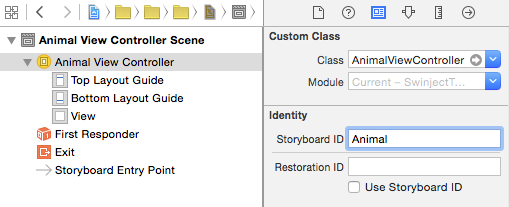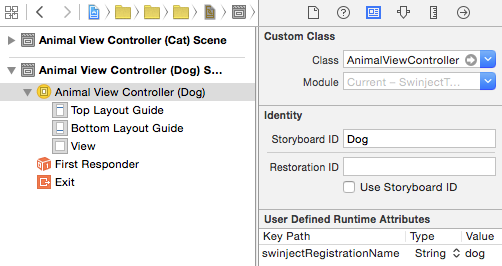Swinject / Swinjectstoryboard
Programming Languages
Projects that are alternatives of or similar to Swinjectstoryboard
SwinjectStoryboard
SwinjectStoryboard is an extension of Swinject to automatically inject dependency to view controllers instantiated by a storyboard.
Requirements
- iOS 8.0+ / Mac OS X 10.10+ / tvOS 9.0+
- Xcode 8+
Installation
Swinject is available through Carthage or CocoaPods.
Carthage
To install Swinject with Carthage, add the following line to your Cartfile.
github "Swinject/Swinject"
github "Swinject/SwinjectStoryboard"
Then run carthage update --no-use-binaries command or just carthage update. For details of the installation and usage of Carthage, visit its project page.
CocoaPods
To install Swinject with CocoaPods, add the following lines to your Podfile.
source 'https://github.com/CocoaPods/Specs.git'
platform :ios, '8.0' # or platform :osx, '10.10' if your target is OS X.
use_frameworks!
pod 'Swinject'
pod 'SwinjectStoryboard'
Then run pod install command. For details of the installation and usage of CocoaPods, visit its official website.
Usage
Swinject supports automatic dependency injection to view controllers instantiated by SwinjectStoryboard. This class inherits UIStoryboard (or NSStoryboard in case of OS X). To register dependencies of a view controller, use storyboardInitCompleted method. In the same way as a registration of a service type, a view controller can be registered with or without a name.
NOTE: Do NOT explicitly resolve the view controllers registered by storyboardInitCompleted method. The view controllers are intended to be resolved by SwinjectStoryboard implicitly.
Registration
Registration without Name
Here is a simple example to register a dependency of a view controller without a registration name:
let container = Container()
container.storyboardInitCompleted(AnimalViewController.self) { r, c in
c.animal = r.resolve(Animal.self)
}
container.register(Animal.self) { _ in Cat(name: "Mimi") }
Next, we create an instance of SwinjectStoryboard with the container specified. If the container is not specified, SwinjectStoryboard.defaultContainer is used instead. instantiateViewControllerWithIdentifier method creates an instance of the view controller with its dependencies injected:
let sb = SwinjectStoryboard.create(
name: "Animals", bundle: nil, container: container)
let controller = sb.instantiateViewControllerWithIdentifier("Animal")
as! AnimalViewController
print(controller.animal! is Cat) // prints "true"
print(controller.animal!.name) // prints "Mimi"
Where the classes and protocol are:
class AnimalViewController: UIViewController {
var animal: Animal?
required init?(coder aDecoder: NSCoder) {
super.init(coder: aDecoder)
}
}
protocol Animal {
var name: String { get set }
}
class Cat: Animal {
var name: String
init(name: String) {
self.name = name
}
}
and the storyboard named Animals.storyboard has AnimalViewController with storyboard ID Animal.
Registration with Name
If a storyboard has more than one view controller with the same type, dependencies should be registered with registration names.
let container = Container()
container.storyboardInitCompleted(AnimalViewController.self, name: "cat") {
r, c in c.animal = r.resolve(Animal.self, name: "mimi")
}
container.storyboardInitCompleted(AnimalViewController.self, name: "dog") {
r, c in c.animal = r.resolve(Animal.self, name: "hachi")
}
container.register(Animal.self, name: "mimi") {
_ in Cat(name: "Mimi")
}
container.register(Animal.self, name: "hachi") {
_ in Dog(name: "Hachi")
}
Then view controllers are instantiated with storyboard IDs similarly to the case without registration names:
let sb = SwinjectStoryboard.create(
name: "Animals", bundle: nil, container: container)
let catController = sb.instantiateViewControllerWithIdentifier("Cat")
as! AnimalViewController
let dogController = sb.instantiateViewControllerWithIdentifier("Dog")
as! AnimalViewController
print(catController.animal!.name) // prints "Mimi"
print(dogController.animal!.name) // prints "Hachi"
Where Dog class is:
class Dog: Animal {
var name: String
init(name: String) {
self.name = name
}
}
and the storyboard named Animals.storyboard has AnimalViewControllers with storyboard IDs Cat and Dog. In addition to the storyboard IDs, user defined runtime attributes are specified as cat and dog for the key swinjectRegistrationName, respectively.
UIWindow and Root View Controller Instantiation
Implicit Instantiation from "Main" Storyboard
If you implicitly instantiate UIWindow and its root view controller from "Main" storyboard, implement setup class method as an extension of SwinjectStoryboard to register dependencies to defaultContainer. When the root view controller (initial view controller) is instantiated by runtime, dependencies registered to defaultContainer are injected.
Note that @objc attribute is mandatory here in swift 4.
extension SwinjectStoryboard {
@objc class func setup() {
defaultContainer.storyboardInitCompleted(AnimalViewController.self) { r, c in
c.animal = r.resolve(Animal.self)
}
defaultContainer.register(Animal.self) { _ in Cat(name: "Mimi") }
}
}
Explicit Instantiation in AppDelegate
If you prefer explicit instantiation of UIWindow and its root view controller, instantiate SwinjectStoryboard with a container in application:didFinishLaunchingWithOptions: method.
@UIApplicationMain
class AppDelegate: UIResponder, UIApplicationDelegate {
var window: UIWindow?
var container: Container = {
let container = Container()
container.storyboardInitCompleted(AnimalViewController.self) { r, c in
c.animal = r.resolve(Animal.self)
}
container.register(Animal.self) { _ in Cat(name: "Mimi") }
return container
}()
func application(
_ application: UIApplication,
didFinishLaunchingWithOptions launchOptions: [UIApplicationLaunchOptionsKey : Any]? = nil) -> Bool {
let window = UIWindow(frame: UIScreen.mainScreen().bounds)
window.makeKeyAndVisible()
self.window = window
let storyboard = SwinjectStoryboard.create(name: "Main", bundle: nil, container: container)
window.rootViewController = storyboard.instantiateInitialViewController()
return true
}
}
Notice that you should delete the Main storyboard file base name item (or UIMainStoryboardFile item if you are displaying raw keys/values) in Info.plist of your app.
Storyboard References
Storyboard Reference introduced with Xcode 7 is supported by SwinjectStoryboard. To enable dependency injection when an instance is created from a referenced storyboard, register dependencies to defaultContainer static property of SwinjectStoryboard.
let container = SwinjectStoryboard.defaultContainer
container.storyboardInitCompleted(AnimalViewController.self) { r, c in
c.animal = r.resolve(Animal.self)
}
container.register(Animal.self) { _ in Cat(name: "Mimi") }
If you implicitly instantiate UIWindow and its root view controller, the registrations setup for "Main" storyboard can be shared with the referenced storyboard since defaultContainer is configured in setup method.
Credits
SwinjectStoryboard is inspired by:
License
MIT license. See the LICENSE file for details.







